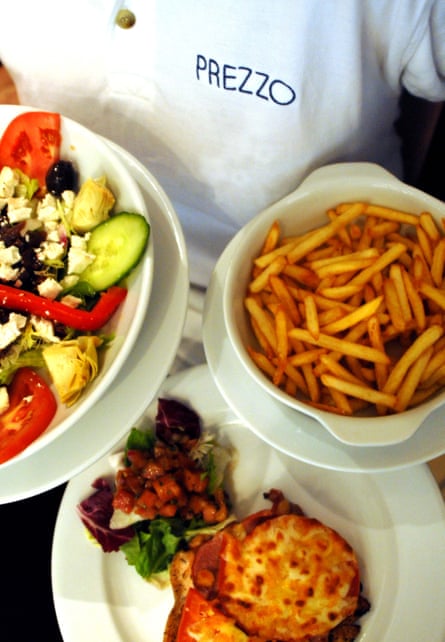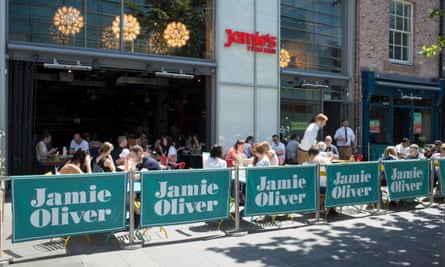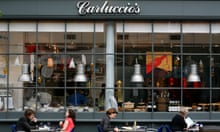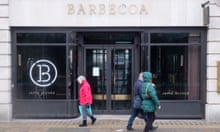In the summer of 2015, restaurant owner David Fox was made an offer he couldn’t refuse. One that today – with financially troubled chains such as Byron and Jamie’s Italian desperately restructuring and closing sites in order to stay afloat – seems to encapsulate the great UK casual dining bubble that has finally, spectacularly, burst.
Fox then had branches of his east Asian restaurant brand, Tampopo, in two huge shopping centres: Oracle in Reading and Cabot Circus in Bristol. He was facing a painful rent increase in Reading but, remarkably, the owners of the centres offered him £1.3m to vacate both sites – such was the clamour, presumably, among the biggest restaurant players to snap up any empty space at top-of-the-market prices.
“In Reading, the rent was £75,000 and they wanted to put it up to £130,000. I was being offered £650,000 to hand over the keys. It was quite unemotional. When someone offers you 10 years’ money, it’s time to move on,” says Fox, who still runs five restaurants in Manchester and London. “It was symptomatic of how giddy the market was and, for most normal brands, it’s kind of unsustainable.”
For Fox, the current turmoil is entirely predictable. Unless every element works perfectly, it is almost impossible to make a return on restaurant sites that might cost £1.5m to open. “I don’t want to sound smug, but we saw it coming,” he says. “There was a lemming-like mentality.” Tampopo’s Bristol site first became a Chimichanga, a reported £600,000 development. It is now a Real Greek. The Reading site is a TGI Fridays.
For a time, between 2010 and 2016, it seemed as if Britain’s burgeoning interest in casual, affordable dining was insatiable. Build that restaurant, no matter how outrageous the property and fit-out costs, and they will come. Tills will ring, card machines will whirr. But in recent months, with the so-called “casual dining crunch” biting hard, that optimism has turned to bleak talk of the industry facing a perfect storm. As well as the problems at Jamie’s and Byron (the former is closing 12 branches and is £71.5m in debt; the latter is in the midst of a financial rescue plan), the Italian chain Strada recently shut a third of its restaurants and its rival Prezzo is now looking at restructuring. Numerous venues, from the five-strong Square Pie group in London to, again, Jamie Oliver’s Piccadilly barbecue restaurant, Barbecoa, have gone into administration. “What we didn’t see coming was Brexit and its implications on exchange rates, recruitment and consumer confidence,” says Fox.

Stefan Chomka, the editor of Restaurant magazine, says: “There are several things in play that, when they come together, is like a house of cards collapsing. First, there’s the oversaturation. Byron expanded rapidly, Pizza Express kept adding, [as did] Nando’s and Zizzi. There has been huge growth in the casual dining market and there are just too many restaurants. Simultaneously, food costs, staff costs, rents and business rates have all gone up. If you’re operating 100 sites, your margins are being squeezed and squeezed. And times are tough. Even if they spend a little more when they do, people are eating out less. So there are greater costs, more competition, fewer people and, consequently, the shit is hitting the fan.”
Had the restaurant industry been expanding cautiously and financing itself from existing turnover, this situation would be tough. Instead, in recent years it has fuelled its expansion by gorging on cheap debt. It has grown fat and complacent and is now suffering the stomach cramps of falling sales.
Quite how the restaurant world became so bloated is a moot point. Many blame a sudden gush of private equity money into food when it seemed it would be the leisure economy of the future. Private equity backers, explains Chomka, want to expand rapidly, then sell up while a brand is still buoyant, usually in a three-to-five-year cycle. This, coupled with the availability of cheap bank debt and a new willingness among retail landlords to fill failing former shop units with restaurants, set the scene for unprecedented growth and ridiculous splurging as operators tried to financially outmuscle one another for sites: “The benchmark for how much people are prepared to pay for sites in rents and premiums has risen and risen.”
A 2016 YouGov poll commissioned by the shopping centre management company Intu rated eating out as Britain’s favourite leisure activity. In 2017, the government’s Insolvency Service reported a 20% rise in restaurant failures. In the meantime, whole streets, areas of towns and new leisure developments became overrun with too many samey mid-market chains. “It’s idiocy by the landlords,” says Will Beckett, the co-founder of the upmarket Hawksmoor steak restaurants.

What Beckett will not accept, however, is that private equity is the bogeyman here (the private equity firm Graphite Capital took a minority stake in Hawksmoor in 2013). “The whole ‘private equity is evil’ thing doesn’t stand up to much scrutiny. There is good and bad private equity, as there are good and bad independents. There is a danger in restaurant companies growing too fast, compromising on quality and weakening the brand. But [private equity investors] know all that. I have a private equity board. We talk about that stuff all the time. If we have to compromise to grow, we tend not to. They understand that.”
For Simon Potts, the MD of the private equity-backed Alchemist cocktail bar and restaurant group – which, bucking the trend, will open four sites this year to add to its existing 13 – the issue is not investment, but rigorous planning. “You’ve got to be realistic,” he says. “We won’t have 150 locations, probably 70 maximum. If you tell [investors] you’re going to do 40 sites, however, it’s not unreasonable for them to expect 40. That’s where the pressure comes from.”
A pressure that can easily lead to large chains, no matter how they are funded, eroding the food quality or service that once made them stand out. When the market is sluggish and a restaurant chain’s headline sales growth slows down, that chain will attempt to protect its profitability by cutting costs, from ingredients to staffing levels. It can quickly become a spiral of decline as quality falls and customers walk.
That sense that large chains are constantly cynically whittling away at their costs fuels huge resentment among foodies. For instance, who would have thought that Jamie’s Italian – a brand supposedly popularising rustic, artisanal Mediterranean cooking – would share a meat supplier, the now-collapsed Russell Hume, with budget pub chain Wetherspoons?
Chef Gary Usher owns four bistros in the north-west of England, including his flagship Sticky Walnut in Chester, which pride themselves on “proper” cooking. He scoffs at the large chains blaming external factors – which are punishing for independents, too – for their woes. Yes, last year’s business rates reassessment hit hard (according to analysis by Colliers International, the Jamie Oliver Restaurant Group’s rates went up 28%, or £1.6m), but there could be a far simpler reason why they are struggling. “Strada being in trouble doesn’t surprise me one bit: it’s fucking awful,” he says. “Why do they deserve to stay open? Strada, Côte – I despise Côte – Carluccio’s, Jamie’s, they should be fucking closing. I ate in the Liverpool Jamie’s two months ago and it was possibly the worst meal I’ve ever had. It was appalling. I ordered what was supposed to be sausage ragout. It looked like boiled tomatoes with overcooked pasta, and it tasted the same.”
For Potts, the rot often sets in far earlier. Rapidly expanding chains simply “forget the principles that made them fantastic”. Byron failed to replicate its early neighbourhood feel; its remote branches lacked personality. Jamie’s Italian failed to replace Oliver’s star quality as he morphed from a TV chef into a health campaigner. “Now, perhaps, people are more excited about eating at Gino D’Acampo’s,” says Potts. The ITV chef has just announced he will open at least five more restaurants by 2019.
To an extent, this is simply fashion. “Brands go through a natural life cycle,” concedes Chomka. He hopes that Byron will act as a cautionary warning of “how quickly a brand can go from being the second coming to closing up to 20 sites”. Will the chains keep coming? Perhaps at a slower rate, but yes. The market is too big, too lucrative, and while distinctive brands such as Nando’s and Wagamama thrive, even in these testing circumstances, restaurateurs will dream of a national presence.

Russell Norman is best known for his Polpo restaurants, the Exeter and Bristol branches of which closed last month. “Not because of market conditions, we got it wrong,” he clarifies by email, while expressing his dismay at those who, as he sees it, are revelling in the misfortune of failing operators. Norman may criticise individual chains privately, but anyone willing to do battle in the parlous world of restaurants and wafer-thin profit margins has his respect.
Norman recently announced a deal with TRG Concessions (part of the huge Restaurant Group that owns Frankie & Benny’s) to roll out his New York-inspired bar, Spuntino, into UK airports – a curveball move for this once impeccably cool Soho hangout. “It’s a unique opportunity to reach a much larger audience without capital expenditure,” he says. “Our investment is intellectual, culinary and artistic. It’s very exciting.”
But is this not the whole problem: credible brands getting into bed with large, profit-hungry organisations? Polpo’s slow expansion has been achieved using “very modest self-generated funds”. What is wrong with that holistic approach?
“You cannot blame people for wanting success, nor equate a desire for business growth with greed,” says Norman. “Good restaurateurs could stick with their first success, but ambition isn’t always bad, is it? It carries risks. It doesn’t mean we shouldn’t take them.
“The question reminds me of Bowie releasing Let’s Dance. Everyone screamed ‘sellout!’ and thought Bowie was being coerced by his label. They wanted its cool, edgy, esoteric predecessors Lodger and Scary Monsters. But Bowie wanted commercial success and a wider audience, so he hired Nile Rodgers and Let’s Dance was a smash hit.”
For some restaurateurs, going big will always be its own justification. Wish Russell Norman luck. In the current climate, he will need it.










Comments (…)
Sign in or create your Guardian account to join the discussion